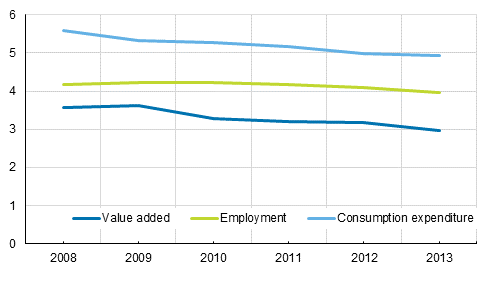Published: 28 October 2015
Role of culture in the national economy is still declining
The role of culture in economy has continued decreasing since the deepest recession. This trend is visible in production, employment and consumption alike. These data derive from Statistics Finland's Culture Satellite Accounts. The games industry is one of the few clearly growing sub-areas of culture, although its significance in the whole cultural economy is not yet that big. Most of the activity of the games industry remains outside the limitations of the cultural satellite, but separate calculations have been made on the whole games industry.
Percentage share of fields of culture in the national economy in 2008 to 2013, ESA 2010

The decline in the value added of culture and simultaneously its share in GDP has been relatively higher than that of the consumption of and employment in the field of culture. Despite the downward trend, culture still has an important role in the national economy; around five per cent of consumption, some four per cent of employment, and about three per cent of GDP.
Also, measured in current prices, the value added of culture decreased in 2013 even though it grew slightly annually in 2010 to 2012. However, there was growth in some groups in 2013 as well, especially in the fields of live culture and event organising. In contrast, it is especially worrying that the number of employed persons in the fields of culture has been declining in absolute terms ever since the beginning of the recession in 2008.
In term of consumption, the figures for 2013 show the TV licence becoming the public broadcasting tax; the TV licence was included in private consumption so its abolition decreases private consumption and the public broadcasting tax becomes visible in the public consumption of culture, which will rise correspondingly in 2013. In current prices, the same sum was spent on culture as in 2012 when considering both private and public consumption expenditure, but the proportion of culture in all consumption expenditure decreases slightly.
The employment share of culture is in relative terms clearly higher than its shares of value added and output, which were now around three per cent each. There are several reasons for the labour domination of culture: the employed in the fields of culture are very often working at a relative low pay level and cultural enterprises do not include that many companies that produce large profits. In addition, part-time employment is very common among the employed in several fields of culture.
Cultural activities have conventionally been regarded as a type of small-scale activity that balances economic trends. When a downturn hits, the role of culture usually grows slightly because cultural activities include several permanent elements. The share of non-profit and public activities is significant and the role of various types of voluntary work is large there. For the most part, culture is not a primary route to riches, but culture is also produced in bad times even without making any profit. However, these slowing down elements were no longer able to prevent the share from declining in a prolonged recession.
The employment and GDP shares of culture rose in the early 2000s and were still growing at the beginning of the recession in 2008. Their share also increased in the worst recession year in 2009. Culture will thus not be an actual growth engine for the national economy in future either except for a few individual fields, but it can be considered an indirect stimulus provider.
Games industry stays mostly outside the current cultural satellite
Beside the culture satellite, Statistics Finland has also calculated total development between 2006 and 2013 for the games industry that has recently received much publicity. The games industry as a whole is, broadly seen, one of the few growing sub-areas of culture. An extremely strong growth, or actually a breakaway, happened in the games industry in 2013. However, the growth was mainly directed at a few enterprises.
However, most game developer companies are working in the industry of programming, which is not included in the cultural satellite industries in these calculations. Only around two to three per cent of the value added generated by games industry enterprises is produced inside the fields of culture. If games industry enterprises were as a whole included in the satellite, they would raise the value added of culture in 2013 by approximately six per cent, but employment clearly more. Thus, the games industry is not a magic cure for the cultural economy - much less for the national economy, at least not yet.
The statistics on Culture Satellite Accounts depict the economic significance of culture, using the concepts and methods of National Accounts. Data according to the Standard Industrial Classification TOL 2008 have now been released for the years 2008 to 2013 in accordance with the ESA2010 system.
The data for the Culture Satellite Accounts are published on the statistics website as database tables.
Source: Culture Satellite Accounts, Statistics Finland
Inquiries: Katri Soinne 029 551 2778, Aku Alanen 029 551 3320, kansantalous@stat.fi
Director in charge: Ville Vertanen
Publication in pdf-format (205.0 kB)
- Tables
-
Tables in databases
Pick the data you need into tables, view the data as graphs, or download the data for your use.
Appendix tables
Updated 28.10.2015
Statistics:
Culture satellite accounts [e-publication].
ISSN=2323-9905. 2013. Helsinki: Statistics Finland [referred: 19.12.2025].
Access method: http://stat.fi/til/klts/2013/klts_2013_2015-10-28_tie_001_en.html

